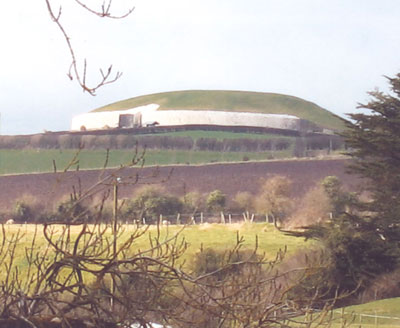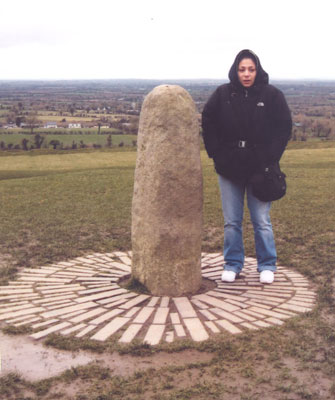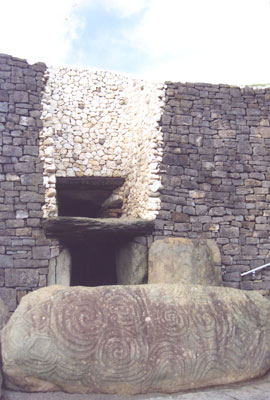Holy places: Pilgrimage to Tara & Newgrange, Ireland
This item appears on page 69 of the October 2009 issue.
by Julie Skurdenis
Twenty-five years ago I made my first “pilgrimage” to two of Ireland’s holiest places: the Hill of Tara and Newgrange. With me was my newly adopted Chilean daughter, 4-year-old Katie. What Katie remembers from that trip are the sheep nibbling Tara’s grassy mounds and the eerie darkness of the Newgrange tomb.
It was time to update those memories, so, on a trip to Dublin in March ’09, Katie and I decided to revisit both sites.
It’s not easy to see both Tara and Newgrange on a day trip from Dublin unless one drives, which neither of us wanted to do. We were lucky to discover Mary Gibbons Tours, a company that visits both on a day excursion.
A visit to Tara requires vivid use of one’s imagination. On the day we went it was cold, with threatening clouds scudding across the sky. As we left the tour bus, crossed a churchyard and squeezed through a narrow opening in a stone wall, all we could see in front of us were grassy banks, trenches and mounds.
Abode of the high kings
Tara is one of the richest places in Ireland for legends, but it is also a place of history where real, flesh-and-blood kings once lived and ruled, including Cormac MacAirt, who reigned for 40 years and is considered one of the greatest of the Irish high kings, and Laoghaire, whom St. Patrick tried unsuccessfully to convert in the fifth century AD.
Today you can see where royal buildings once stood. Within the enormous oval enclosure called the Ráith na Ríg (Fort of the Kings) are found many of the most important remains at Tara, including the Grave Mound of the Hostages, a burial place that archaeologists estimate to be about 4,500 years old.
Two ring forts lying side by side nearby may once have been the site of royal residences 2,000 years ago. In one of the ring forts stands the Lia Fáil, supposedly the inauguration stone of the Irish high kings.
Outside this enclosure lie dozens of other ring forts, consisting of circular or oval banks and trenches, as well as two tall parallel banks, 660 feet long, that may once have been an enormous banquet hall described in the 12th-century Book of Leinster.
At Tara, if you look only with eyes you will see only small, grassy hills. If you look with the imagination, you will people these hills with the kings and heroes of Ireland’s past.
Abode of the dead
From Tara we journeyed to Newgrange, located in the Boyne Valley, an area rich in prehistoric remains, including 40 burial mounds similar to the one we were about to visit.
When the Irish kings reigned at Tara, Newgrange was already thousands of years old. Built as a place of burial about 3200 BC, Newgrange predates both the Egyptian pyramids and Stonehenge. It also predates the oldest mound at Tara, the Mound of the Hostages, by about 700 years.
Newgrange is enormous — about 300 feet in diameter and rising in height to 40 feet. The mound is held in place by huge kerbstones, some carved with arcs, circles, spirals and swirls — perhaps an artist’s abstract conception of the changing seasons, perhaps merely decorative. The entrance to the tomb is faced with white quartz.
Kerbstone One
Immediately in front of the entrance to the tomb is one of archaeology’s most famous stones. Called rather unimaginatively Kerbstone One, it’s covered with spirals and was a barrier to those entering the tomb, perhaps reminding those about to go inside that they were leaving the land of the living to enter the land of the dead.
Today’s visitor climbs a wooden staircase and platform over the stone before entering the tomb — a way of protecting this 5,000-year-old treasure.
Another thing that’s changed since our visit of 25 years ago is that visitors are now bused from the visitor center in small groups to the burial mound. They are then guided inside along a narrow, 60-foot-long passage lined with huge stones to three burial chambers at the end that once held the remains of the dead.
Winter solstice
On the morning of the winter solstice, December 21, the first beams of the sun would enter the tomb and travel slowly along the passageway until finally reaching and illuminating these three chambers. The guide illustrated how this worked as we watched, spellbound.
No one knows for sure whether Newgrange was a royal burial mound or if those living in the Boyne Valley community of five millennia ago were also buried here. There are so many other mounds nearby that Newgrange and the others may have served as communal “graveyards.” Newgrange has been listed as a UNESCO World Heritage Site.
It seemed appropriate that as we emerged from the darkness of the tomb, the threatening clouds of earlier in the day had disappeared and the sun brilliantly shone on the valley spread out before us and on the white stone facing of the tomb’s entrance.
If you go. . .
We journeyed to the Hill of Tara and Newgrange with Mary Gibbons Tours, the only company we could find that goes to both sites and that guarantees entrance into the Newgrange tomb (very important, since you can arrive at Newgrange only to find that all the daily visitor slots have already been allocated).
The day excursion costs €35 each, about $47 when we visited, including transportation and admission.
Mary Gibbons Tours (12 St. Catheryns Court, Newgrove Ave., Sandymount, Dublin 4, Ireland; phone 086 355 1355, www.newgrangetours.com) also offers afternoon tours to the monastic complex of Glendalough and to the gardens of Powerscourt.



